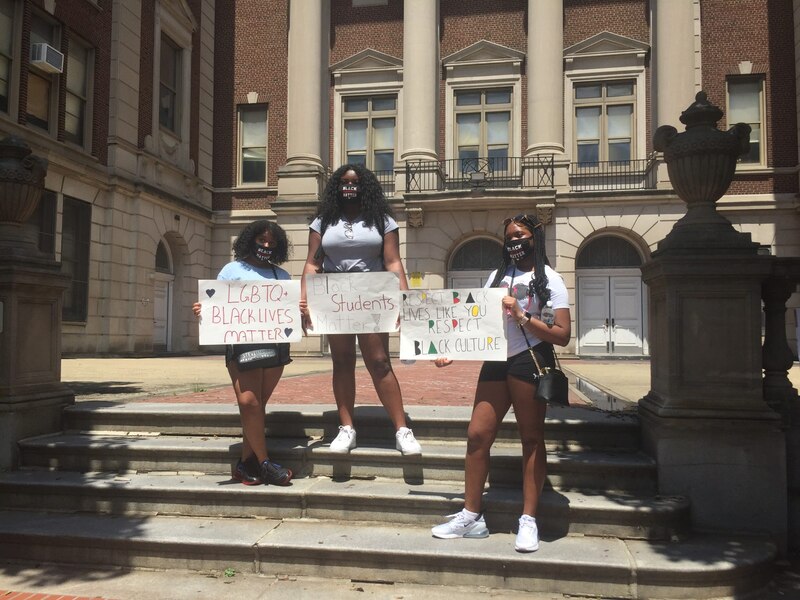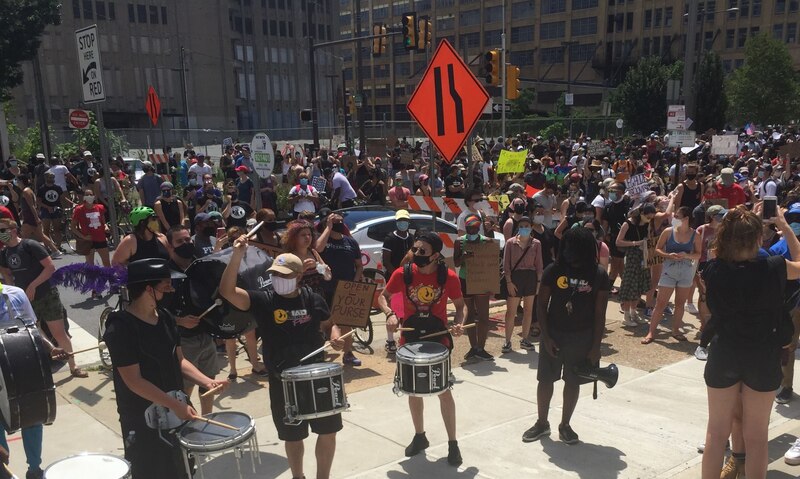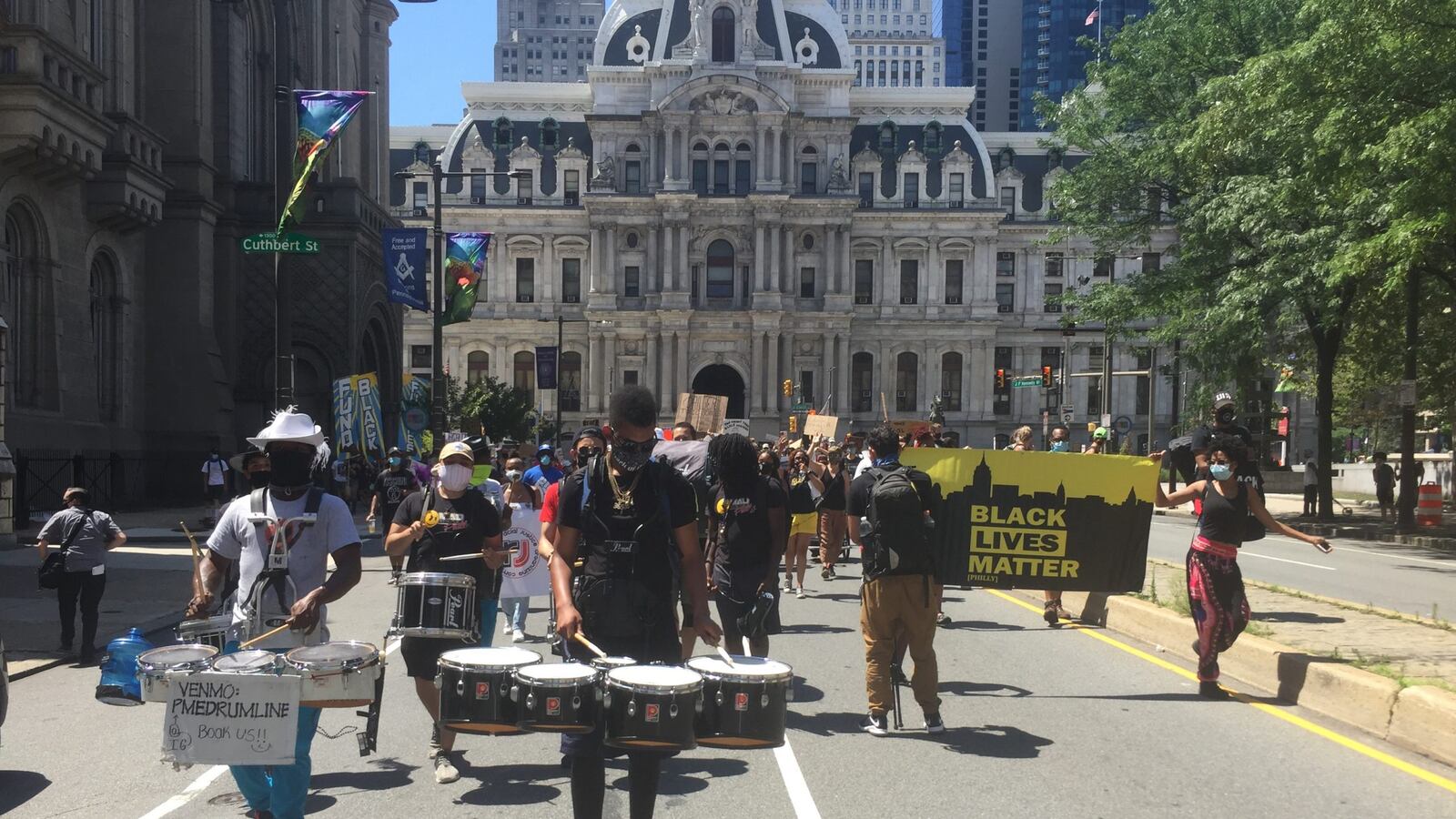This article was originally published in The Notebook. In August 2020, The Notebook became Chalkbeat Philadelphia.
From toxins in educational facilities, to plummeting representation at selective schools, to white classmates casually dropping the n-word, Black students in Philadelphia say they face racism all the time and they are fed up.
That rage spilled over in a Sunday protest where hundreds of students, alumni, teachers, and community members packed Center City to demand justice for the more than 100,000 Black students in the city’s District and charter schools. They marched from City Hall to the District’s headquarters, at 440 N. Broad St.
“Walk as if you’re transforming education with your feet,” said Keziah Ridgeway, a teacher at Northeast High School and graduate of Philadelphia High School for Girls. “I am where I am today in spite of my racist counselor and racist teachers.”
The march was organized by teacher groups, including the Melanated Educators Collective and the Racial Justice Organizing Committee.
Marching to the beat of an accompanying fleet of drummers, the protesters – most wearing masks – shouted “No justice, no peace” and carried signs that read “Fund Black Futures.” They then stopped at the District headquarters, where organizers and students delivered several impassioned speeches.
Dana Carter, one of the organizers, mentioned that dozens of Black-majority schools in Philadelphia were forced to close their doors in the last decade. City Councilwoman Kendra Brooks decried the crumbling school buildings in Philadelphia. Carcinogenic, loose asbestos fibers have been found in many District schools in the last few years. Other building issues include lead in water fountains and collapsing ceilings, which Brooks said disproportionately impacts students of color.
Students at Masterman and Central High Schools also called attention to the fact that the Black population has been steadily declining at the selective Philadelphia schools. At Central, Black students make up around 20% of enrollment; 10 years ago, it was 35%. At Masterman, the numbers are even more jarring – throughout the 1990s, the Black population remained steady around 50%, but now, it’s declined to 15%.
Sheyla Street, a rising senior at Central, said that needs to change.
“We need teachers to encourage students to apply to Masterman, Central, SLA [Science Leadership Academy],” Street said. “We need teachers to tell students ‘you can do that challenging problem.’”
Street also noted that most teachers at Central and Masterman are white and said they can’t understand the experience of Black students at school.
Referring to the teacher hiring committees, Street said: “Who are these people made up of? What do their faces look like? Do they look like mine? Do they reflect my experience? We demand equitable hiring practices, including the recruitment of Black educators.”
Mariame Sissoko, who just graduated from Central High, said that even though many teachers try their best to make students feel welcome, Black and brown students inevitably struggle more with racist experiences.
“We have counselors who, despite their best efforts, do not know how to counteract the effects of anti-Black racism,” said Sissoko.
After the crowd at District headquarters dispersed, a cohort of protesters marched on to Masterman – just four blocks away – for another round of speeches and protests. There, Black Masterman students and alumni shared stories of persecution at the hands of teachers and the administration.
“You can’t claim to be a top school and traumatize your Black students,” said organizer and recent graduate Zora Charles. Masterman’s national rank, according to U.S. News & World Report, rose to 16th this year.
But even with its reputation for being a top school academically, Johari Sankofa, class of 2011, says he remembers one thing distinctly.

Protesters in front of Masterman High School. (Photo: Neena Hagen)
“What I remember from Masterman is being in the office all the time,” Sankofa said. Sankofa recalled white students trying to rile him up by saying the n-word, and he’d get angry and retaliate. “All I heard was ‘Johari, go to the office’… and I was like ‘they said the n-word.’”
Sunday’s protest came on the heels of nationwide conversations about race that occurred after George Floyd, an unarmed Black man, was killed by police in Minneapolis. Teachers began having serious conversations about racism in their classes, and there were District-wide calls to defund the police.
After the news came out earlier this month that Central and Masterman students were using slurs and joking about raping black women in private Instagram group chats, Black teens at the selective schools began pouring out their experiences with racism on social media.

The crowd marches up Broad Street (Photo: Neena Hagen)
Last week at Central High, president Timothy McKenna responded to a list of student demands to improve Black student life at the school. Among other initiatives to combat racial injustice, Central will introduce an equity coordinator position on the faculty and evaluate hiring practices in an effort to employ more Black teachers. Masterman alumni are crafting similar demands.
On Thursday, the District announced that it was recruiting staff and eventually others for a racial equity initiative. Among other actions, it will overhaul curricula to ensure more of a focus on anti-racism, said Superintendent William Hite, and require continuous implicit-bias training for all faculty and staff.
Both organizers and students at the forefront of Philadelphia’s racial justice movement applauded the efforts by their administrators, but insisted there’s still work to be done.
“Dr. Hite and our administrators need to do more,” said Youma Diabira, a rising senior at Central. “Do something or we will.”

